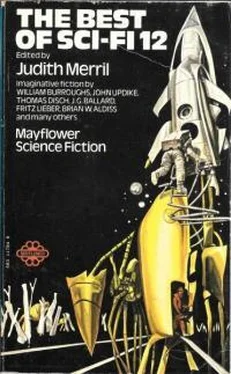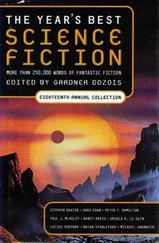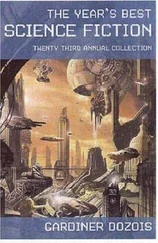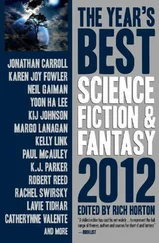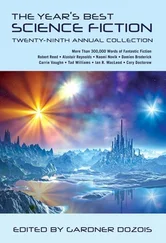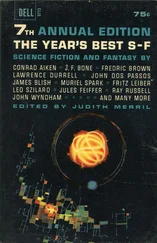The Best of Science Fiction 12
Здесь есть возможность читать онлайн «The Best of Science Fiction 12» весь текст электронной книги совершенно бесплатно (целиком полную версию без сокращений). В некоторых случаях можно слушать аудио, скачать через торрент в формате fb2 и присутствует краткое содержание. Год выпуска: 1970, ISBN: 1970, Издательство: Mayflower, Жанр: Фантастика и фэнтези, на английском языке. Описание произведения, (предисловие) а так же отзывы посетителей доступны на портале библиотеки ЛибКат.
- Название:The Best of Science Fiction 12
- Автор:
- Издательство:Mayflower
- Жанр:
- Год:1970
- ISBN:0583117848
- Рейтинг книги:4 / 5. Голосов: 1
-
Избранное:Добавить в избранное
- Отзывы:
-
Ваша оценка:
- 80
- 1
- 2
- 3
- 4
- 5
The Best of Science Fiction 12: краткое содержание, описание и аннотация
Предлагаем к чтению аннотацию, описание, краткое содержание или предисловие (зависит от того, что написал сам автор книги «The Best of Science Fiction 12»). Если вы не нашли необходимую информацию о книге — напишите в комментариях, мы постараемся отыскать её.
The Best of Science Fiction 12 — читать онлайн бесплатно полную книгу (весь текст) целиком
Ниже представлен текст книги, разбитый по страницам. Система сохранения места последней прочитанной страницы, позволяет с удобством читать онлайн бесплатно книгу «The Best of Science Fiction 12», без необходимости каждый раз заново искать на чём Вы остановились. Поставьте закладку, и сможете в любой момент перейти на страницу, на которой закончили чтение.
Интервал:
Закладка:
"munching"
People began, in a curious way, to locate themselves in relation to aspects of the balloon: "I'll be at that place where it dips down into Forty-seventh Street almost to the sidewalk, near the Alamo Chile House," or "Why don't we go stand on top, and take the air, and maybe walk about a bit, where it forms a tight, curving line with the façade of the Gallery of Modern Art — " Marginal intersections offered entrances within a given time duration, as well as 'warm, soft, lazy passages' in which ... But it is wrong to speak of 'marginal intersections'. Each intersection was crucial, none could be ignored (as if, walking there, you might not find someone capable of turning your attention, in a flash, from old exercises to new exercises). Each intersection was crucial, meeting of balloon and building, meeting of balloon and man, meeting of balloon and balloon.
It was suggested that what was admired about the balloon was finally this: that it was not limited, or defined. Sometimes a bulge, blister, or sub-section would carry all the way east to the river on its own initiative, in the manner of an army's movements on a map, as seen in a headquarters remote from the fighting. Then that part would be, as it were, thrown back again, or would withdraw into new dispositions; the next morning, that part would have made another sortie, or disappeared altogether. This ability on the part of the balloon to shift its shape, to change, was very pleasing, especially to people whose lives were rather rigidly patterned, persons to whom change, although desired, was not available. The balloon, for the twenty-two days of its existence, offered the possibility, in its randomness, of getting lost, of losing oneself, in contradistinction to the grid of precise, rectangular pathways under our feet. The amount of specialised training currently needed, and the consequent desirability of long-term commitments, has been occasioned by the steadily growing importance of complex machinery, in virtually all kinds of operations; as this tendency increases, more and more people will turn, in bewildered inadequacy, to solutions for which the balloon may stand as a prototype, or 'rough draft'.
I met you under the balloon, on the occasion of your return from Norway. You asked if it was mine; I said it was. The balloon, I said, is a spontaneous autobiographical disclosure, having to do with the unease I felt at your absence, and with sexual deprivation, but now that your visit to Bergen has been terminated, it is no longer necessary or appropriate. Removal of the balloon was easy; trailer trucks carried away the depleted fabric, which is now stored in West Virginia, awaiting some other time of unhappiness, sometime, perhaps, when we are angry with one another.
Landscape is a formalisation of space and time. External landscapes directly reflect interior states of mind — in fact the only external landscapes which have any meaning are those which are reflected in the central nervous system by their direct analogues. I think Dali said somewhere that "mind is a state of landscape," and I think this is completely true.
This was J. G. Ballard, in an interview on the BBC, speaking about one of his highly controversial new 'condensed novels', 'You and Me and the Continuum' (recently reprinted in England Swings SF, Doubleday, 1968; another, 'You: Coma: Marilyn Monroe', is included in this volume). But his preoccupation with landscape, not as background only, but as an aspect of characterisation — not as medium but as message — has been integral to his work from the beginning: his first story, 'Prima Belladonna' (1956; most recently in SF: The Best of the Best, Delacorte, 1967), like 'Cloud Sculptors', was set in the oddly timeless brilliance of Vermilion Sands ...
The Cloud-Sculptors of Coral D
J. G. Ballard
All summer the cloud-sculptors would come from Vermilion Sands and sail their painted gliders above the coral towers that rose like white pagodas beside the highway to Lagoon West. The tallest of the towers was Coral D, and here the rising air above the sand-reefs was topped by swan-like clumps of fair-weather cumulus. Lifted on the shoulders of the air above the crown of Coral D, we would carve sea-horses and unicorns, the portraits of presidents and film-stars, lizards and exotic birds. As the crowd watched from their cars, a cool rain would fall on to the dusty roofs, weeping from the sculptured clouds as they sailed across the desert floor towards the sun.
Of all the cloud-sculptures we were to carve, the strangest were the portraits of Leonora Chanel. As I look back to that afternoon last summer when she first came in her white limousine to watch the cloud-sculptors of Coral D, I know we barely realised how seriously this beautiful but insane woman regarded the sculptures floating above her in that calm sky. Later her portraits, carved in the whirlwind, were to weep their storm-rain upon the corpses of their sculptors.
I had arrived in Vermilion Sands three months earlier. A retired pilot, I was painfully coming to terms with a broken leg and the prospect of never flying again. Driving into the desert one day, I stopped near the coral towers on the highway to Lagoon West. As I gazed at these immense pagodas stranded on the floor of this fossil sea, I heard music coming from a sand-reef two hundred yards away. Swinging on my crutches across the sliding sand, I found a shallow basin among the dunes where sonic statues had run to seed beside a ruined studio. The owner had gone, abandoning the hangar-like building to the sandrays and the desert, and on some half-formed impulse I began to drive out each afternoon. From the lathes and joists left behind I built my first giant kites and, later, gliders with cockpits. Tethered by their cables, they would hang above me in the afternoon air like amiable ciphers.
One evening, as I wound the gliders down on to the winch, a sudden gale rose over the crest of Coral D. While I grappled with the whirling handle, trying to anchor my crutches in the sand, two figures approached across the desert floor. One was a small hunchback with a child's overlit eyes and a deformed jaw twisted like an anchor barb to one side. He scuttled over to the winch and wound the tattered gliders towards the ground, his powerful shoulders pushing me aside. He helped me on to my crutches and peered into the hangar. Here my most ambitious glider to date, no longer a kite but a sail-plane with elevators and control lines, was taking shape on the bench.
He spread a large hand over his chest. "Petit Manuel — acrobat and weight-lifter. Nolan!" he bellowed. "Look at this!" His companion was squatting by the sonic statues, twisting their helixes so that their voices became more resonant. "Nolan's an artist," the hunchback confided to me. "He'll build you gliders like condors."
The tall man was wandering among the gliders, touching their wings with a sculptor's hand. His morose eyes were set in a face like a bored Gaugin's. He glanced at the plaster on my leg and my faded flying jacket, and gestured at the gliders. "You've given a cockpit to them, major." The remark contained a complete understanding of my motives. He pointed to the coral towers rising above us into the evening sky. "With silver iodide we could carve the clouds."
The hunchback nodded encouragingly to me, his eyes lit by an astronomy of dreams.
So were formed the cloud-sculptors of Coral D. Although I considered myself one of them, I never flew the gliders, but I taught Nolan and little Manuel to fly, and later, when he joined us, Charles Van Eyck. Nolan had found this blond-haired pirate of the café terraces in Vermilion Sands, a laconic teuton with droll eyes and a weak mouth, and brought him out to Coral D when the season ended and the well-to-do tourists and their nubile daughters returned to Red Beach. "Major Parker — Charles Van Eyck. He's a head-hunter," Nolan commented with cold humour," — maidenheads." Despite their uneasy rivalry I realised that Van Eyck would give our group a useful dimension of glamour.
Читать дальшеИнтервал:
Закладка:
Похожие книги на «The Best of Science Fiction 12»
Представляем Вашему вниманию похожие книги на «The Best of Science Fiction 12» списком для выбора. Мы отобрали схожую по названию и смыслу литературу в надежде предоставить читателям больше вариантов отыскать новые, интересные, ещё непрочитанные произведения.
Обсуждение, отзывы о книге «The Best of Science Fiction 12» и просто собственные мнения читателей. Оставьте ваши комментарии, напишите, что Вы думаете о произведении, его смысле или главных героях. Укажите что конкретно понравилось, а что нет, и почему Вы так считаете.
